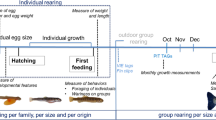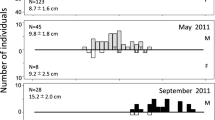Abstract
Egg size contributes to other life history traits of an individual. It is traditionally considered as a maternally determined characteristic to which the male does not have any direct contribution. However, a recent finding in insects suggests that males can affect egg size also directly. In fish, the male effect could take place only during egg swelling, as the final egg size is reached after that. We studied egg size in four freshwater salmonid species (the land-locked Atlantic salmon, the brown trout, the Arctic charr and the lake trout) right after fertilisation (initial egg size) and after the swelling phase (final egg size). The results showed that the final egg size is affected not only by the initial egg size but also by both the female and the male through the process of egg swelling. This study suggests that paternal contribution may form a previously largely ignored source of variation in early life history traits in salmonid fish.
Similar content being viewed by others
References
Alderdice, D.F. (1988) Osmotic and ionic regulation in teleost eggs and larvae. In W.S. Hoar and D.J. Randall (eds) Fish Physiology, Vol. XIA. Academic Press, Inc., London, pp. 163-251.
Bernardo, J. (1996a) The particular maternal effect of propagule size, especially egg size: patterns, models, quality of evidence and interpretation. Am. Zool. 36, 216-236.
Bernardo, J. (1996b) Maternal effects in animal ecology. Am. Zool. 36, 83-105.
Blaxter, J.H.S. (1986) Development of sense organs and behavior of teleost larvae with special reference to feeding and predator avoidance. Trans. Am. Fish. Soc. 115, 98-114.
Bolin, R.L. (1930) Embryonic development of the labrid fish, Oxyjulis californicus Günther. Copeia 1930, 122-128.
Chambers, R.C. (1997) Environmental influences on egg and propagule sizes in marine fishes. In R.C. Chambers and E.A. Trippel, (eds) Early Life History and Recruitment in Fish Populations. Chapman and Hall, London, pp. 63-102.
Chambers, R.C. and Leggett, W.C. (1996) Maternal influences on variation in egg sizes in temperate marine fishes. Am. Zool. 36, 180-196.
Chapman, D.W. (1988) Critical review of variables used to define effects of fines in redds of large salmonids. Trans. Am. Fish. Soc. 117, 1-21.
Crill, W.D., Hucy, R.B. and Gilchrist, G.W. (1996) Within-and between-generation effects of temperature on the morphology and physiology of Drosophila melanogaster. Evolution 50, 1205-1218.
Daan, S., Dijkstra, C. and Tinbergen, J. (1990) Family planning in the kestrel (Falco tinnunculus) -- the ultimate control of covariation of laying date and clutch size. Behaviour 114, 83-116.
Einum, S. and Fleming, I.A. (1999) Maternal effects of egg size in brown trout (Salmo trutta): norms of reaction to environmental quality. Proc. R. Soc. Lond. B 266, 2095-2100.
Fox, C.W. and Mousseau, T.A. (1998) Maternal effects as adaptations for trans-generational phenotypic plasticity in insects. In T.A. Mousseau and C.W. Fox (eds) Maternal Effects as Adaptations. Oxford University Press, New York, pp. 159-177.
Groot, E.P. and Alderdice, D.F. (1985) Fine structure of the external egg membrane of five species of Pacific salmon and steelhead trout. Can. J. Zool. 63, 552-566.
Gwynne, D.T. (1984) Courtship feeding increases female reproductive success in bushcrickets. Nature 307, 361-363.
Heath, D.D. and Blouw, D.M. (1998) Are maternal effects in fish adaptive or merely physiological side effects? In T.A. Mousseau and C.W. Fox (eds) Maternal Effects as Adaptations. Oxford University Press, New York, pp. 178-201.
Hutchings, J.A. (1991) Fitness consequences of variation in egg size and food abundance in brook trout Salvelinus fontinalis. Evolution 45, 1162-1168.
Kamler, E. (1992) Early Life History of Fish: an Energetics Approach. Chapman and Hall, London.
Kaplan, R.H. (1980) The implications of ovum size variability for offspring fitness and clutch size within several populations of salamanders (Ambystoma). Evolution 34, 51-64.
Kaplan, R.H. (1998) Maternal effects, developmental plasticity, and life history evolution: an amphibian model. In T.A. Mousseau and C.W. Fox (eds) Maternal Effects as Adaptations, Oxford University Press, New York, pp. 244-260.
Kjesbu, O.S., Solemdal, P., Bratland, P. and Fonn, M. (1996) Variation in annual egg production in individual captive Atlantic cod (Gadus morhua). Can. J. Fish. Aquat. Sci. 53, 610-620.
Laale, H.W. (1980) The perivitelline space and egg envelopes of bony fishes: a review. Copeia 1980, 210-226.
Lahnsteiner, F., Weismann, T. and Patzner, R.A. (1999) Physiological and biochemical parameters for egg quality determination in lake trout, Salmo trutta lacustris. Fish Phys. Biochem. 20, 375-388.
Li, X., Jenssen, E. and Fyhn, H.J. (1989) Effects of salinity on egg swelling in Atlantic salmon (Salmo salar). Aquaculture 76, 317-334.
Lønning, S. and Davenport, J. (1980) The swelling egg of the rough dab, Hippoglossoides plates-soides limandoides (Bloch). J. Fish Biol. 17, 359-378.
Miller, T.J., Crowder, L.B., Rice, J.A. and Marschall, E.A. (1988) Larval size and recruitment mechanisms in fishes: toward a conceptual framework. Can. J. Fish. Aquat. Sci. 45, 1657-1670.
Mousseau, T.A. and Fox, C.W. (1998) The adaptive significance of maternal effects. Trends Ecol. Evol. 13, 403-407.
Reznick, D. (1991) Maternal effects in fish life histories. In E. Dudley (ed.) Evolutionary Biology. Discorides Press, Portland, Oregon, pp. 780-793.
Rombough, P.J. (1988) Respiratory gas exchange, aerobic metabolism, and effects of hypoxia during early life. In W.S. Hoar and D.J. Randall (eds) Fish Physiology, Vol. XIA. Academic Press, Inc., London, pp. 59-161.
Sakaluk, S.K. (1986) Sperm competition and the evolution of nuptial feeding behavior in the cricket, Gryllodes supplicans (Walker). Evolution 40, 584-593.
Sokal, R.R. and Rohlf, F.J. (1995) Biometry: the Principles and Practice of Statistics in Biological Research. 3rd edn. W.H. Freeman and Company, New York.
Tukey, J.W. (1949) One degree of freedom for non-additivity. Biometrics 5, 232-242.
van den Berghe, E.P. and Gross, M.R. (1989) Natural selection resulting from female breeding competition in a Pacific salmon (coho: Oncorhynchus kisutch). Evolution 43, 125-140.
Weigensberg, I., Carrière, Y. and Roff, D.A. (1998) Effects of male genetic contribution and paternal investment to egg and hatchling size in the cricket, Gryllus firmus. J. Evol. Biol. 11, 135-146.
Author information
Authors and Affiliations
Rights and permissions
About this article
Cite this article
Pakkasmaa, S., Peuhkuri, N., Laurila, A. et al. Female and male contribution to egg size in salmonids. Evolutionary Ecology 15, 143–153 (2001). https://doi.org/10.1023/A:1013873810905
Issue Date:
DOI: https://doi.org/10.1023/A:1013873810905




